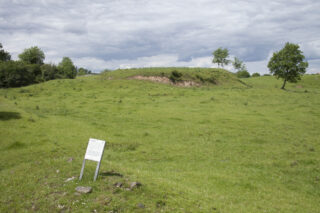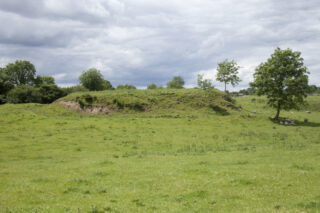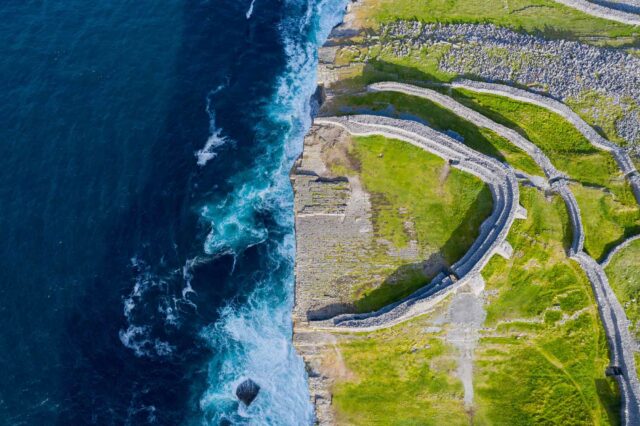Fógra
WARNING: It should be noted that these sites are unguided and a level of care and caution should be maintained during all stages of your visit. The Office Of Public Works (OPW) will not be held responsible for any damages, injuries, or losses that occur
Magh Adhair
This ring barrow, Bullaun stone, cairn and Inauguration site are examples of prehistoric ceremonial landscapes. The area of Magh Adhair is associated with some of the earliest medieval royal assembly’s and inaugurations, as it is the assembly site of Dál gCais.
The ring barrow is probably a Bronze Age burial mound, has the Hell River to its south-west and was named Mound of Magh Adhair. The mound has not been excavated, but its use in inauguration ceremonies was significant. The mound is flat-topped, sloping to the south, is surrounded by a fosse and outer bank of stone and earth. Two possible entry points exist across the fosse via causeways of earth and stone, but these may be medieval modifications.
The mound was the place of inauguration of the Dalcassian kings, Kings of Thomond, including Brian Ború. Some believe that the mound is the burial place of the first century Firbolg warrior Adair, brother of Aengus of Aran, architect of Dún Aonghasa. The Annals of the Four Masters mentions Magh Adhair in 877AD. That year the High King, Flan Sunagh of the Uí Néill tribe, challenged the honour of the kings of Thomond at Magh Adhair by setting up a chess board on the inauguration mound. The Dalcassians were enraged, and their king, Lorcan, destroyed the chess board. Sunagh fled to the woods and was forced to surrender three days later.
In 982AD, the Annals tells us that another attack to the honour of the Dalcassian occurred. This time, another High King, Máel Sechnaill mac Domnaill (again of the Uí Néill tribe), attacked Magh Adhair and cut down and dug out the bile, a sacred inauguration tree.
By the 13th century, Magh Adhair was the established site for the inauguration of the O’Briain/Uí Bhriain descendants. The historical account of the Uí Bhriain dynasty is gleaned from the Catherim Thoirdhealbhaigh (Triumphs of Torlough) written by Séan mac Ruaidhrí Mac Craith in Irish in the 14th century, who was the family historian. The account spans from 1194 to 1318 and notes seven inaugurations of Uí Bhriains that took place at Magh Adhair from 1242 to 1313.
The cairn is 9m west of the inauguration mound. The cairn is sub-rectangular, and flat-topped with an earthen ramp. Cairns in general were constructed of piles of stones, usually conical in shape and used as a boundary marker, burial site, or memorial.
The Bullaun stone is located 31m north of the inauguration mound. It has an unusual composition, as it is made of Old Red Sandstone. The connection between the Bullaun stone and the inauguration site is unknown. Bullaun comes from the Irish word Bullán, meaning bowl. Typically, the Bullaun stone would have a hollow basin which would contain a smooth pebble. A folk tradition in Ireland identifies these pebbles as cursing stones. Folklore says if you wanted to put a curse on someone turn the pebble anti- clockwise during the morning. However, the curse had to be fair and just; if it wasn’t the curse would come to you that evening.
Visit Historic Environment Viewer for more information on Magh Adhair
Protect our Past - Click here to read about the importance of protecting our country’s unique heritage sites
This national monument is protected in accordance with the National Monuments Acts 1930 to 2014
Gailearaí
Suíomhanna cóngarach
Ionad Cuairteoirí agus Páirc- Cois Locha Loch Goir
9,000 bliain den saol
Timpeall 41.0 km ón
Caisleán Dheasumhan – An Caisleán Nua Thiar
Áit a ndéanann fuaimeanna ragairne na meánaoise macalla timpeall na mballaí
Timpeall 46.2 km ón
Caisleán agus Gairdíní Phort Omna
Breáthacht ón seachtú haois déag ar bhruacha Loch Deirgeirt
Timpeall 49.0 km ón



